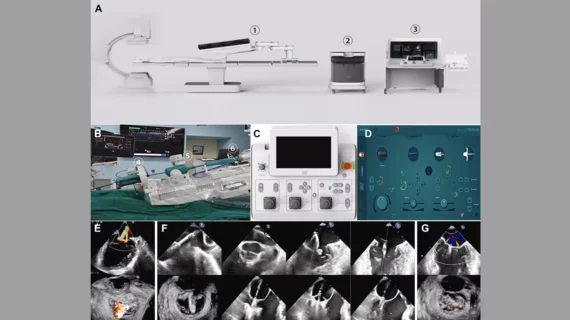Cardiologists and surgeons perform world’s first robot-assisted TEER
Cardiac surgeons and interventional cardiologists in China have completed the very first robot-assisted transcatheter edge-to-edge repair (TEER), sharing their initial findings in JACC: Cardiovascular Interventions.[1]
“A robotic endovascular procedure has the advantage of improved stability and reduced radiation,” explained first author Da Zhu, MD, a structural heart specialist at Fuwai Yunnan Hospital in China, and colleagues.
Zhu et al. performed the first-in-human procedure using echocardiography and a robotics system designed to be compatible with Abbott’s MitraClip technology “or other TEER devices sharing a similar design.” The system included a robotic articulating arm, a control computer and a cockpit. The arm is capable of steering the guiding catheter, delivery sheath and control catheter. The cockpit includes three joysticks and several additional buttons used to move the articulating arm when necessary.
The patient in question was a 62-year-old woman presenting with severe mitral regurgitation and recurrent heart failure episodes that did not improve after medical therapy. A transesophageal echocardiogram (TEE) found that the patient had an effective regurgitation orifice area of 0.4 cm2 and an ejection fraction of 32%.
The echo-guided TEER was performed under general anesthesia. A 24 French guiding sheath was placed in the patient’s left atrium and then the robotics system took over, placing the clip in the A2/P2 region of the mitral valve.
The procedure was a success, leaving just trace amounts of MR, and took a total of 38 minutes.
“The postoperative period was uneventful,” the authors wrote. “The patient was discharged on the fourth day. This first-in-man application demonstrates the initial feasibility and safety of a robotic-assisted TEER procedure.”
Funding was provided by the National Key Research and Development Program and Major Science and Technology Special Plan Project of Yunnan Province.
Click here to read the team’s full analysis in JACC: Cardiovascular Interventions, an American College of Cardiology journal.

